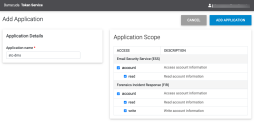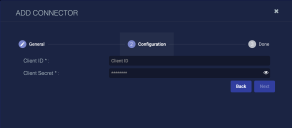Configuring Barracuda Email Connectors
If your environment includes integration with Barracuda's Email Security Service, you can configure a connector in Stellar Cyber to create an external email remediation incident in a Barracuda Forensics And Incident Response deployment, based on Stellar Cyber alerts.
Connector Overview: Barracuda Email
Capabilities
-
Collect: No
-
Respond: Yes
-
Native Alerts Mapped: No
-
Runs on: DP
-
Interval: N/A
Collected Data
N/A
Domain
|
https://api.barracudanetworks.com |
Response Actions
|
Action |
Required Fields |
|---|---|
barracuda.account_id and barracuda.subject and barracuda.env_from and barracuda.hdr_from |
Third Party Native Alert Integration Details
N/A
Required Credentials
-
Client ID and Client Secret
Let us know if you find the above overview useful.
Adding a Barracuda Email Connector
To add a new Barracuda email connector:
- Verify the Barracuda configuration
- Enable API Access / Obtain Credentials
- Add the connector in Stellar Cyber
- Test the connector
Verifying the Barracuda Configuration
This connector is intended to support deployments with Barracuda already integrated. The following are needed before you proceed:
-
You must already have a Barracuda Cloud Control / Email Protection account set up. (https://ess.barracudanetworks.com/)
-
Your email service must already be integrated with Barracuda Email Security as a gateway. (Steps are provided on the Barracuda documentation website.)
-
Configure SYSLOG parsing for port 5559 on the Barracuda email server and on your Stellar Cyber sensor.
Enabling API Access
-
Use the Barracuda token service to register an application for communication between Stellar Cyber and the Barracuda Email Gateway Defense system. Log in to: https://login.bts.barracudanetworks.com/register. (Steps are also provided on Barracuda's documentation site.)
-
Click Add Application.
-
Ensure you select the option to permit read/write, which allows you to submit response actions from Stellar Cyber.
-
After you save the application, make note of the Client ID and Client Secret. If you forget these, you can retrieve the ID but not the secret, you would need to use the token web page to reset the secret.
Adding the Connector in Stellar Cyber
To add a Barracuda Email Security connector in Stellar Cyber:
-
Log in to Stellar Cyber.
-
Click System | Integration | Connectors. The Connector Overview appears.
-
Click Create. The General tab of the Add Connector screen appears. The information on this tab cannot be changed after you add the connector.
The asterisk (*) indicates a required field.
-
Choose Email from the Category drop-down.
-
Choose Barracuda Email Security from the Type drop-down.
-
For this connector, the supported Function is Respond, which is enabled already.
-
Enter a Name.
Notes:- This field does not accept multibyte characters.
- It is recommended that you follow a naming convention such as tenantname-connectortype.
-
Choose a Tenant Name. The Interflow records created by this connector include this tenant name.
-
Choose the device on which to run the connector.
-
Click Next. The Configuration tab appears.
The asterisk (*) indicates a required field.
-
Enter the Client ID and Client Secret noted in the previous section.
-
Click Next. The final confirmation tab appears.
-
Click Submit.
The new connector is immediately active.
Testing the Connector
When you add (or edit) a connector, we recommend that you run a test to validate the connectivity parameters you entered. (The test validates only the authentication / connectivity; it does not validate data flow).
For connectors running on a sensor, Stellar Cyber recommends that you allow 30-60 seconds for new or modified configuration details to be propagated to the sensor before performing a test.
-
Click System | Integrations | Connectors. The Connector Overview appears.
-
Locate the connector that you added, or modified, or that you want to test.
-
Click Test at the right side of that row. The test runs immediately.
Note that you may run only one test at a time.
Stellar Cyber conducts a basic connectivity test for the connector and reports a success or failure result. A successful test indicates that you entered all of the connector information correctly.
To aid troubleshooting your connector, the dialog remains open until you explicitly close it by using the X button. If the test fails, you can select the button from the same row to review and correct issues.
The connector status is updated every five (5) minutes. A successful test clears the connector status, but if issues persist, the status reverts to failed after a minute.
Repeat the test as needed.
If the test fails, the common HTTP status error codes are as follows:
| HTTP Error Code | HTTP Standard Error Name | Explanation | Recommendation |
|---|---|---|---|
| 400 | Bad Request | This error occurs when there is an error in the connector configuration. |
Did you configure the connector correctly? |
| 401 | Unauthorized |
This error occurs when an authentication credential is invalid or when a user does not have sufficient privileges to access a specific API. |
Did you enter your credentials correctly? Are your credentials expired? Are your credentials entitled or licensed for that specific resource? |
| 403 | Forbidden | This error occurs when the permission or scope is not correct in a valid credential. |
Did you enter your credentials correctly? Do you have the required role or permissions for that credential? |
| 404 | Not Found | This error occurs when a URL path does not resolve to an entity. | Did you enter your API URL correctly? |
| 429 | Too Many Requests |
This error occurs when the API server receives too much traffic or if a user’s license or entitlement quota is exceeded. |
The server or user license/quota will eventually recover. The connector will periodically retry the query. If this occurs unexpectedly or too often, work with your API provider to investigate the server limits, user licensing, or quotas. |
For a full list of codes, refer to HTTP response status codes.










